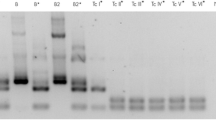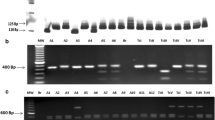Abstract
To investigate whether Trypanosoma cruzi populations found in chagasic cardiopathic and non-cardiopathic patients are genetically differentiated, three molecular microsatellite markers were analysed. This analysis was also applied to compare T. cruzi samples from peripheral blood or dejections of Triatoma infestans fed on the blood of the same patients. In order to obtain the first objective, analyses of predominant T. cruzi genotypes were conducted using three approaches: a locus-by-locus analysis; a Fisher method across three loci; and analysis of molecular variance by Genepop and Arlequin programs. Only with one locus and on the blood samples was a significant differentiation detected among non-cardiopathic and cardiopathic groups, which was not confirmed by the other two methods. On the contrary, with the three approaches, it was found that T. cruzi clones present in the blood of patients are genetically differentiated from those detected in dejections of T. infestans fed on the same patients. Our results showed that the most frequent lineage both in blood as well as in triatomine dejection samples was TcI. No significant difference in T. cruzi lineage distribution was observed among chagasic cardiopathic and non-cardiopathic patients. The majority of the samples (50–60%) had only one T. cruzi clone (uniclonal) either in blood or dejection samples.

Similar content being viewed by others
References
Acosta AM, Santos-Buch CA (1985) Autoimmune myocarditis induced by Trypanosoma cruzi. Lab Invest 71:1255–1261
Anderson TJC, Su X-Z, Bockarie M, Lagog M, Day KP (1999) Twelve microsatellite markers for characterization of Plasmodium falciparum from finger-prick blood samples. Parasitology 119:113–125
Apt W, Aguilera X, Arribada A, Perez C, Miranda C, Sanchez G, Zulantay I, Cortes P, Rodriguez J, Juri D (1998) Treatment of chronic Chagas’ disease with itraconazole and allopurinol. Am J Trop Med Hyg 59:133–138
Apt W, Arribada A, Zulantay I, Sánchez G, Vargas SL, Rodríguez J (2003) Itraconazole or allopurinol in the treatment of chronic American trypanosomiasis: the regression and prevention of electrocardiographic abnormalities during 9 years of follow-up. Ann Trop Med Parasitol 97:23–29
Breniere SF, Bosseno MF, Revollo S, Rivera MT, Tibayrenc M (1992) Direct identification of Trypanosoma cruzi natural clones in vectors and host blood by PCR technique. Am J Trop Med Hyg 46:335–341
Breniere SF, Bosseno MF, Telleria J, Bastrenta B, Yaksic N, Noireau F, Alcazar JL, Barnabé C, Wincker P, Tibayrenc M (1998) Different behavior of two Trypanosoma cruzi major clones: transmission and circulation in young Bolivian patients. Exp Parasitol 89:285–295
Brisse S, Barnabé C, Tibayrenc M (2000) Identification of six Trypanosoma cruzi phylogenetic lineages by random amplified polymorphic DNA and multilocus enzyme electrophoresis. Int J Parasitol 30:35–44
Buscaglia CA, Di Noia JM (2003) Trypanosoma cruzi clonal diversity and the epidemiology of Chagas’ disease. Microbes Infect 5:419–427
Coronado X, Zulantay I, Albrecht H, Rozas M, Apt W, Ortiz S, Rodríguez J, Sánchez G, Solari A (2006) Variation in Trypanosoma cruzi clonal composition detected in blood patients and xenodiagnosis triatomines: implications in the molecular epidemiology of Chile. Am J Trop Med Hyg 74:1008–1012
Coura J, Junqueira A, Fernandes O, Valente S, Miles M (2002) Emerging Chagas’ disease in Amazonian Brazil. Trends Parasitol 18:171–176
Deane MP, Soussa MA, Preira NM, Goncalves AM, Momen H, Morel CM (1984) Trypanosoma cruzi: inoculations schedules and reisolation methods select individual strains from doubly infected mice, as demonstrated by schizodeme and zymodeme analysis. J Protozool 231:2765–280
De Freitas JM, Augusto-Pinto L, Pimental JR, Bastos-Rodrigues L, Vanessa F, Gonçalves VF, Teixeira SMR, Chiari E, Junqueira ACV, Fernández O, Macedo AM, Machado CR, Pena SDJ (2006) Ancestral genomes, sex, and the population structure of Trypanosoma cruzi. PLoS Pathog 2:0226–0235
Excoffier L, Smouse P, Quattro J (1992) Analysis of molecular variance inferred from metric distance among DNA haplotypes. Application to human mitochondrial restriction data. Genetics 131:479–491
Higuchi ML, Benvenuti LA, Reis MM, Metzger M (2003) Pathophysiology of the heart in Chagas’ disease: current status and new developments. Cardiovasc Res 60:96–107
Llewelyn MS, Miles MA, Carrasco HJ, Lewis MD, Yeo M, Segobia M, Vargas J, Torrico F, Diosque P, Valente V, Valente S, Gaunt MW (2009a) Genome-scale multilocus microsatellite typing of Trypanosoma cruzi discrete typing unit reveals phylogeographic structure and specific genotypes linked to human infection. PLoS Pathog 5:1–9
Llewelyn MS, Lewis MD, Acosta N, Yeo M, Carrasco HJ, Vargas J, Torrico F, Miles MA, Gaunt MW (2009b) Trypanosoma cruzi IIc: phylogenetic and phylogeographic insights from sequence and microsatellite analysis and potential impact on emergent Chagas disease. Plos Neglected Tropical Diseases 3:1–10
Macedo AM, Martins SM, Chiari E, Pena SDJ (1992) DNA fingerprinting of Trypanosoma cruzi: a new tool for characterization of strains and clones. Mol Biochem Parasitol 55:147–154
Macedo AM, Pimenta J, Aguiar RS, Melo AIR, Chiari E, Zingales B, Pena SDJ, Oliveira RP (2001) Usefulness of microsatelites typing in population genetic studies of Trypanosoma cruzi. Mem Inst Oswaldo Cruz 96:407–413
Macedo AM, Oliveira RP, Pena SDJ (2002) Chagas disease: role of parasite genetic variation in pathogenesis. Expert Rev Mol Med 4:1–16
Miles M, Cedillos R, Povoa M, de Souza A, Prata A, Macedo V (1981) Do radically dissimilar Trypanosoma cruzi strains (zymodemes) cause Venezuelan and Brazilian forms of Chagas’ disease? Lancet 1:1338–1340
Morel C, Chiari E, Plessmann Camargo E, Mattei DM, Romanha AJ, Simpsont L (1980) Strains and clones of Trypanosoma cruzi can be characterized by pattern of restriction endonuclease products of kinetoplast DNA minicircles. Proc Natl Acad Sci USA 77:6810–6814
Oliveira RP, Broude NE, Macedo AM, Cantor CR, Smith CL, Pena SDJ (1998) Probing the genetic population structure of Trypanosoma cruzi with polymorphic microsatellites. Proc Natl Acad Sci USA 95:3776–3780
Pereira Silva C, Del Carlo CH, de Oliveira Junior MT, Scipioni A, Strunz-Cessaro C, Franchini JA, Pereira AC (2008) Why do patients with chagasic cardiomyopathy have worse outcomes than those with non-chagasic cardiomiopathy. Arq Bras Cardiol 91:358–362
Piry S, Alapetite A, Cornuet J-M, Paetkau D, Baudouin L, Estoup A (2004) GeneClass2: a software for genetic assignment and first-generation migrant detection. J Hered 95:536–539
Rannala B, Mountain JL (1997) Detecting immigration by using multilocus genotypes. Proc Natl Acad Sci USA 94:9197–9201
Rozas M, Botto-Mahan C, Coronado X, Ortiz S, Cattan PE, Solari A (2007) Coexistence of Trypanosoma cruzi genotypes in wild and periodomestic mammals in Chile. Am J Trop Med Hyg 77:647–653
Raymond M, Rousset F (1995a) An exact test for population differentiation. Evolution 49:1283–1286
Raymond M, Rousset F (1995b) GENEPOP version 1.2: population genetics software for exact tests and ecumenicism. J Hered 86:248–249
Rodrigues Coura J, Pinto Dias JC (2009) Epidemiology, control and surveillance of Chagas disease 100 years after its discovery. Mem Inst Oswaldo Cruz 104:31–40
Schenone H (1999) Xenodiagnosis. Mem Inst Oswaldo Cruz 94:289–294
Schneider S, Roessli D, Excoffier L (2000) Arlequin: a software for population genetic data. Genetics and Biometry Laboratory, University of Geneva, Switzerland
Solari A, Campillay R, Ortiz S, Wallace A (2001) Identification of Trypanosoma cruzi genotypes circulating in Chilean chagasic patients. Exp Parasitol 97:226–233
Tibayrenc M, Ayala F (1988) Isoenzyme variability in T. cruzi, the agent of Chagas disease: genetical, taxonomical and epidemiological significance. Evolution 42:277–292
Tibayrenc M, Ayala JF (1991) Towards a population genetic of microorganisms: the clonal theory of parasitic protozoa. Parasitol Today 7:228–232
Tibayrenc M, Ayala F (1999) Evolutionary genetics of Trypanosoma and Leishmania. Microbes Infect 1:465–472
Tibayrenc M, Ward P, Moya A, Ayala FJ (1986) Natural populations of Trypanosma cruzi, the agent of Chagas disease, have a complex multiclonal structure. Proc Natl Acad Sci USA 83:115–119
Torres JP, Ortiz S, Muñoz S, Solari A (2004) Trypanosoma cruzi isolates from Chile are heterogeneous and composed of mixed populations when characterized by schizodeme and Southern analyses. Parasitology 128:161–168
Venegas J, Coñoepan W, Pichuantes S, Miranda S, Apt W, Arribada A, Zulantay I, Coronado X, Rodriguez J, Reyes E, Solari A, Sánchez G (2009a) Differential distribution of Trypanosama cruzi clones in human chronic cardiopathic and non-cardiopathic individuals. Acta Trop 109:187–193
Venegas J, Coñoepan W, Sergio Pichuantes S, Miranda S, Jercic MI, Gajardo M, Sánchez G (2009b) Phylogenetic analysis of microsatellite markers further supports the two hybridization events hypothesis as the origin of the Trypanosoma cruzi lineages. Parasitol Res 105:191–199
Weir BS, Cockerham CC (1984) Estimating the F-statistics for the analysis of population structure. Evolution 38:1358–1370
Zingales B, Souto BR, Mangia R, Lisboa C, Campbell D, Coura J, Jansen A, Fernandes O (1998) Molecular epidemiology of American trypanosomiasis in Brazil based on dimorphisms of rRNA and mini-exon gene sequences. Int J Parasitol 28:105–112
Zingales B, Stolf B, Souto R, Fernandes O, Briones M (1999) Epidemiology, biochemistry and evolution of Trypanosoma cruzi lineages based on ribosomal RNA sequences. Mem Inst Oswaldo Cruz 94:159–164
Zingales B, Andrade SG, Briones MRS, Campbell DA, Chiari E, Fernandes O, Guhl F, Lages-Silva E, Macedo AM, Machado CR, Miles MA, Romanha AJ, Sturm NR, Tibayrenc M, Schijman AG (2009) A new consensus for Trypanosoma cruzi intraspecific nomenclature: second revision meeting recommends TcI to TcVI. Mem Inst Oswaldo Cruz 104:1051–1054
Zulantay I, Honores P, Sánchez G, Apt W, Ortiz S, Osuna A, Rojas A, López B, Solari A (2004) Use of polymerase chain reaction and hybridization assay to detect Trypanosoma cruzi in chronic chagasic patients treated with itraconazole and allopurinol. Diagn Microbiol Infect Dis 48:253–257
Zulantay I, Apt W, Gil LC, Rocha C, Mundaca K, Solari A, Sánchez G, Rodríguez C, Martinez G, De Pablos LM, Sandobal L, Rodríguez J, Vilchez S, Osuna A (2007) The PCR based-detection of Trypanosoma cruzi in the faeces of Triatoma infestans fed on patients with chronic American trypanosomiasis gives higher sensitivity and a quieker result than routine xenodiagnosis. Ann Trop Med Parasitol 101:673–679
Acknowledgements
This study was supported by FONDECYT, nos. 1040731 and 1070837. We would like to thank Prof. Jorge Rodriguez at the Escuela de Salud Pública, Facultad de Medicina, Universidad de Chile for help with the statistical analysis of the T. cruzi lineages, shown in Table 3.
Author information
Authors and Affiliations
Corresponding author
Electronic supplementary materials
Below is the link to the electronic supplementary material.
Fig. S1
Frequency of multiclonality based on Trypanosoma cruzi microsatellite markers SCLE10, SCLE11 and MCLE01in four sample groups. N-B and C-B: groups of blood samples from 42 non-cardiopathic or 32 cardiopathic chagasic patients, respectively. N-X and C-X: groups of dejection samples from Triatoma infestans fed on the same 42 non-cardiopathic or 32 cardiopathic chagasic patients, respectively (xenodiagnosis, see “Materials and methods”). Numbers on the left represent the minimal number of T. cruzi clones detected in each sample (DOC 24.5 kb)
Fig. S2
Lineage frequency of predominant Trypanosoma cruzi clones found in cardiopathic and non cardiopathic chagasic patients. N-B and C-B: groups of blood samples from 42 non-cardiopathic or 32 cardiopathic chagasic patients, respectively. N-X and C-X: groups of dejection samples from Triatoma infestans fed on the same 42 non-cardiopathic or 32 cardiopathic chagasic patients, respectively (xenodiagnosis, see “Materials and methods”). Lineage nomenclature according to Zingales et al. (2009) (DOC 24.5 kb)
Table S1
Genetic patterns of Trypanosoma cruzi clones found in peripheral blood and xenodiagnosis of chagasic patients determined by microsatellite markers SCLE10, SCLE11 and MCLE01 (DOC 709 kb)
Table S2
Efficiency of T. cruzi microsatellite markers SCLE10, SCL11 and MCLE01 in cardiopathic and non-cardiopathic chagasic individuals (DOC 27.0 kb)
Rights and permissions
About this article
Cite this article
Venegas, J., Miranda, S., Coñoepan, W. et al. Microsatellite marker analysis shows differentiation among Trypanosoma cruzi populations of peripheral blood and dejections of Triatoma infestans fed on the same chronic chagasic patients. Parasitol Res 107, 855–863 (2010). https://doi.org/10.1007/s00436-010-1939-2
Received:
Accepted:
Published:
Issue Date:
DOI: https://doi.org/10.1007/s00436-010-1939-2




